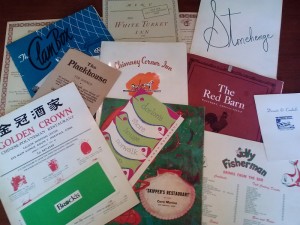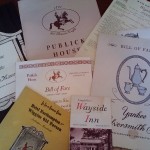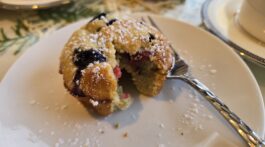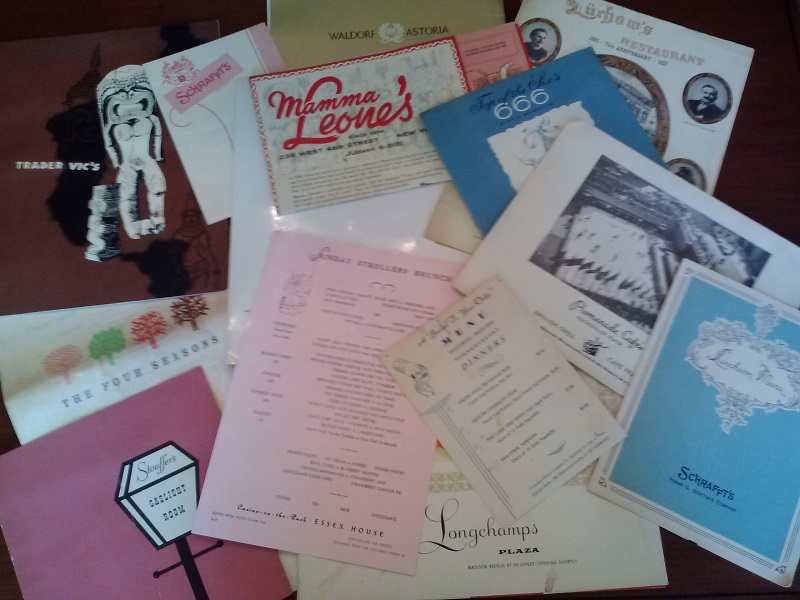Up in the attic I found a box of old menus collected by my father. I had forgotten about them, but now recall emptying a desk and banishing them under the eaves. Not interesting at the time, they were too good to throw away. A classic keep or discard conundrum solved by a spacious attic.
My father, as owner of the Silvermine Tavern, was an avid menu collector. Before the internet, in the early days of mass communication, the only way to survey the competition and keep tabs on trends was to visit, eat, and bring home a menu to study. I recall, too, that he always asked for a tour of the kitchen.
The menus open a window into restaurants from the mid 50s to the mid 70s. The prices, a punch line by today’s standards, end in small increments, 15, 45 or 60 cents, back when a nickel or a dime was a significant amount of revenue. There was some French language from the places with higher aspirations. Most of the offerings are hopelessly out of favor by today’s standards, but a few dishes have been consistent over the years: Filet Mignon and Strip Steak are perennial favorites, Lobsters were popular then and now, and Lamb Chops were always an upscale choice. Some things have gone out of favor and since returned – Fried Chicken for one. Calves Liver, rarely seen today, was a menu stalwart, as was Ham, Salisbury steak and Vichyssoise.
Restaurants in the 50s and 60s were not specialized as is the case now. There were seafood and steak establishments, but most were for a general audience with a broad and diverse menu. Some were a little more upscale, with “continental” as the designation, but most were American. By the 70s, some restaurant specialization entered the marketplace with places like The Plankhouse for steak, Victoria Station for prime rib and The Mermaid Tavern for updated New England.
The menus break down into four general categories: local restaurants, regional establishments with a New England-Colonial-Country Inn theme, New York City sophisticates and a miscellany of restaurants from places my folks traveled, cruise ship menus, and a significant subset of Cape Cod restaurants where we used to spend time in the summer.
 Well- known local restaurants from 50 or so years ago include a large group in the New England/Country Inn category, most in converted barns or mills, that flourished with the opening of the Merritt Parkway: Fox Hill – Ridgefield, Chimney Corner – Stamford, The Roger Sherman – New Canaan, The White Turkey – Danbury, The Three Bears – Westport, The Spinning Wheel – Redding and the only two still in business – The Red Barn and Stonehenge.
Well- known local restaurants from 50 or so years ago include a large group in the New England/Country Inn category, most in converted barns or mills, that flourished with the opening of the Merritt Parkway: Fox Hill – Ridgefield, Chimney Corner – Stamford, The Roger Sherman – New Canaan, The White Turkey – Danbury, The Three Bears – Westport, The Spinning Wheel – Redding and the only two still in business – The Red Barn and Stonehenge.
Seafood was a big category in Norwalk including The Jolly fisherman, Dorlon’s Shore House, Skippers and The Clam Box. In the family/casual arena there was Phil Bakers (an Italian mainstay for our family that was wiped out by the new Rt-7), and in Westport Ruth Norman’s Bon Appetit, Werners and The Friendly Hearth. “Exotic” asian food was available at the Golden Crown and West Lake (which served Sealtest exclusively according to the menu). Innovative restaurant concepts shook up the dining scene in the form of The Red Coach Grill, the Peppermill, Brocks (with its steak and salad bar menu) and Fat Tuesday – the first stylish restaurant in the center of New Canaan.
 Regional New England Inns include these purveyors of chowder, chicken pot pie and Indian pudding: Longfellow’s Wayside Inn, The Hawley Manor, Wiggins old Tavern at the Hotel Northampton, The Publick House, The Yankee Silversmith, The Abner Wheeler House, The Ben Grosvenor Inn, Altamont, and The 1812 House. No menu was in the collection, but this list also has to include The Toll House Inn, source of the famous cookie.
Regional New England Inns include these purveyors of chowder, chicken pot pie and Indian pudding: Longfellow’s Wayside Inn, The Hawley Manor, Wiggins old Tavern at the Hotel Northampton, The Publick House, The Yankee Silversmith, The Abner Wheeler House, The Ben Grosvenor Inn, Altamont, and The 1812 House. No menu was in the collection, but this list also has to include The Toll House Inn, source of the famous cookie.
The New York menus include stalwarts and innovators alike. I’m sure my folks made an occasional pilgrimage to the Big Apple to see the latest trends and study operations in the restaurant big leagues of NYC. Some are still familiar today like the Waldorf Astoria, The Essex House, The Carlyle (hotel dining was much more Important then), The Four Seasons, The Promenade Cafes at Rockefeller Center and Mama Leone’s. There were trendy new themed restaurants then too, pioneered by the innovative Restaurant Associates company, like La Fonda del Sole and Trader Vic’s. Important special occasion restaurants included The Top of the Sixes, Luchow’s and Longchamps. Of particular interest to my Dad were busy high-quality high-volume establishments like Schrafft’s, Stouffer’s, and even Horn & Hardart – they had restaurants, too, in addition to the famous Automats.
Today, lots of ethnic cuisines are close by and both innovative and traditional restaurants abound. It’s illuminating to look back at the early days of the post-war restaurant boom to see how much things have changed. Personally, I feel lucky to have so many exciting options for eating out—it’s what I like to do!
In a future article, I’ll explore some of the contemporary trends and lingo of the current restaurant scene. Meanwhile, I’d love to have some of your remembrances of restaurants of the past!












No Comment